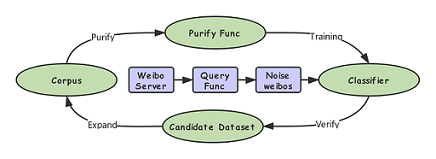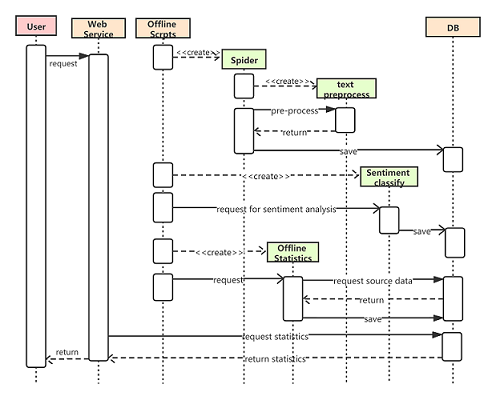[S2AP]: A Sequential Senti-weibo Analysis Platform.
| Download link | Desc | |
|---|---|---|
| Senti-weibo | Google Drive | 671053 weibos, 407058 positive, 263995 negative |
| Test-Dataset | Google Drive | 1790 weibos, 1010 negative, 780 positive |
| Trained-Model by fastText | Google Drive | 1.74 GB |
| Public-Weibo-Dataset | Google Drive | 955MB, 35.2 million weibos |
Training and test scripts can be available at training_and_test.py
Details at README
We open-source the crawled weibos about the topic of Huawei and China-US Trade.
| Topic | Download Link | Time |
|---|---|---|
| Huawei | Google Drive | 2019-03-12 — 2019-07-01 |
| China-US Trade | Google Drive | 2019-04-20 — 2019-07-01 |
Open-sourced on Github. In order to prove the significance of consistent text pre-processing rules in the training and online environment, we compare six segmentation tools with this script: segmentation_tools_compare.py.
Demo
$ pip install weibo-preprocess-toolkitfrom weibo_preprocess_toolkit import WeiboPreprocess
preprocess = WeiboPreprocess()
from weibo_preprocess_toolkit import WeiboPreprocess
toolkit = WeiboPreprocess()
test_weibo = "所 以 我 都 不 喝 蒙 牛, 一 直 不 喜 歡 蒙 牛。 #南 京· 大 行 宫[地 点]# 赞[122]转发[11] [超 话] 收 藏09月11日 18:57"
cleaned_weibo = toolkit.clean(test_weibo)
print(cleaned_weibo)
# ’所 以 我 都 不 喝 蒙 牛 一 直 不 喜 欢 蒙 牛’
print(toolkit.cut(cleaned_weibo))
# [’所 以’, ’我’, ’都’, ’不 喝’, ’蒙 牛’, ’一 直’, ’不 喜 欢’, ’蒙 牛 ’]
print(toolkit.preprocess(test_weibo , simplified=True , keep_stop_word=True))
# ’所 以 我 都 不 喝 蒙 牛 一 直 不 喜 欢 蒙 牛’In fact, the iteration can be interpreted as a process of sifting sands out of flour. Given a sieve and some flour to be sifted, our goal is to sift out the sand with sieve. The difficulty is that the holes on the sieve are not all small holes, there will always be sands mixed into flour. Purify Function plays an important role in this part. Classifier trained by initialized corpus will lead to over-fitting iff we apply it to purify the corpus. So we divide the corpus into training set and verification set, and sample subset of training dataset to train the classifier many times. Multiple classifiers are used to verify the sentiment label of the verification dataset, and then sift out the samples whose classification results are not unified. Query Function can help to continuously recall new high-quality data to guarantee the robustness of the model.
Details at Website-snapshot



